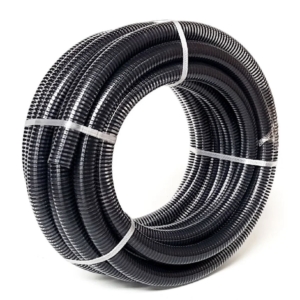What is an Air Seeder Hose?
An air seeder hose is a flexible, durable tube used in agricultural seeding systems to transport seeds, fertilizers, or other granular materials to the seeding or planting machinery. These hoses work by relying on air pressure to move materials through the system efficiently and evenly. Air seeder hoses are crucial for ensuring that seeds are sown in a consistent manner, which is vital for healthy crop growth. An air seeder hose is a critical component in modern agricultural equipment, specifically designed to deliver air and seed to the soil with precision. It acts as a conduit, ensuring the seamless flow of materials while resisting wear and tear. Air seeder hose is a clear suction and discharge hose, It is made of a clear PVC/TPU bore and a black PVC/TPU spiral making it ideal for use in applications where the material being conveyed needs to be seen. This lightweight, flexible hose is resistant to crushing, abrasion, and shocks. The mirror’s smooth bore minimizes friction. It can also be used in vacuum cleaning, slurry and sludge transfer, gravity feed, fume removal, dust collection, water conveyance, and other similar applications.

air seeder hose
The Role of Air Seeder Hose in Agriculture
In agriculture, air seeder hoses play a pivotal role in ensuring efficient seed distribution and soil aeration. They connect the seeder tank to the distribution system, allowing for precise seed placement and optimal germination conditions.
Improved Efficiency and Performance
Quality air seeder hoses contribute to improved efficiency by ensuring consistent seed distribution and minimizing air leaks. This leads to more uniform crop emergence and higher yields.
Durability and Longevity
Investing in a high-quality air seeder hose can save you time and money in the long run. Quality hoses are less prone to wear and tear, reducing the need for frequent replacements and repairs.
Cost-effectiveness in the Long Run
While quality hoses may come at a higher initial cost, their durability and performance benefits often translate into long-term cost savings. They require less maintenance, offer better reliability, and contribute to improved crop yields, making them a worthwhile investment.
Top Picks for Air Seeder Hoses
Experts recommend investing in quality air seeder hoses from reputable manufacturers known for producing durable, reliable, and high-performance products. Consider factors like material quality, design, compatibility, and warranty when selecting a hose that meets your farming needs and budget.
Customer Feedback and Testimonials
Customer feedback and testimonials provide valuable insights into the performance, reliability, and satisfaction levels associated with different air seeder hoses and systems. Research reviews, ratings, and recommendations from other farmers to make informed decisions and choose a hose that delivers on its promises.
Industry Insights and Market Trends
Stay informed about industry insights, market trends, and innovations in air seeder hose technology by following industry news, attending trade shows, and networking with industry professionals. Explore emerging trends, new technologies, and market developments to stay ahead of the competition and make strategic investments in your farming operations.

air seeder hoses
Key Features of Air Seeder Hoses
Durability and Flexibility
Air seeder hoses must be both durable and flexible to withstand the demands of the agricultural environment. They need to resist wear and tear from constant movement, exposure to the elements, and rough handling.
Resistance to Abrasion and Weather
A high-quality air seeder hose must be resistant to abrasions, UV rays, and other environmental factors. This ensures that the hose continues to perform optimally even after prolonged use.
Anti-static Properties
Static electricity can build up during the operation of air seeder hoses, which could lead to issues such as blockages or equipment malfunction. Many air seeder hoses are designed with anti-static properties to mitigate these risks.
Conclusion
In conclusion, air seeder hoses play a crucial role in modern agriculture by facilitating efficient seed distribution, soil aeration, and crop growth. By investing in quality hoses, following maintenance and care tips, and staying informed about industry trends and innovations, farmers can enhance efficiency, improve productivity, and achieve long-term success in their farming operations.
FAQs
What is an air seeder hose used for?
An air seeder hose is used in agriculture to deliver air and seed to the soil with precision, facilitating efficient seed distribution, soil aeration, and crop growth.
How do I choose the right size and material for my air seeder hose?
When choosing an air seeder hose, consider your equipment’s specifications, operating conditions, and performance requirements. Select a hose that matches your equipment’s size, is made from durable materials like polyurethane or rubber or PVC, and offers resistance to abrasion, UV rays, and chemicals.
What are the common maintenance practices for air seeder hoses?
Common maintenance practices for air seeder hoses include regular inspection for signs of wear or damage, cleaning to remove dirt and debris, proper storage away from direct sunlight and extreme temperatures, and following manufacturer’s guidelines for handling and usage.
How often should I replace my air seeder hose?
The frequency of air seeder hose replacement depends on usage, operating conditions, and maintenance practices. Inspect your hose regularly for signs of wear or damage and replace it when necessary to prevent leaks, blockages, and reduced efficiency.
Are there any eco-friendly options available for air seeder hoses?
Yes, there are eco-friendly air seeder hose options available made from recycled materials, biodegradable polymers, and environmentally friendly manufacturing processes. These options can help reduce environmental impact, conserve resources, and support sustainable farming practices.

 sunhose
sunhose sunhose
sunhose